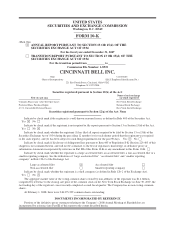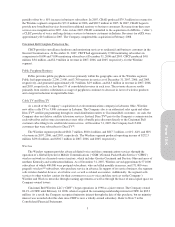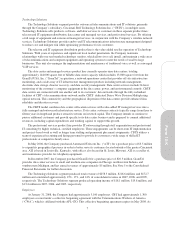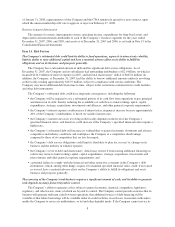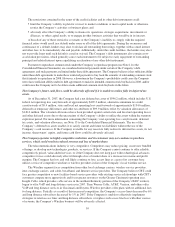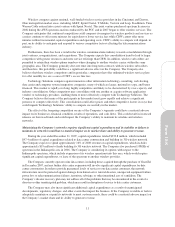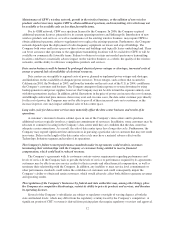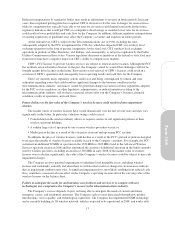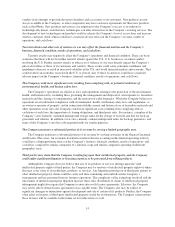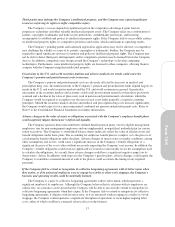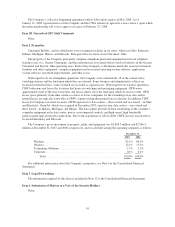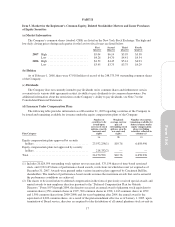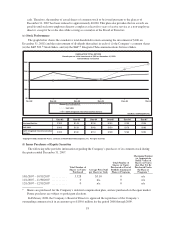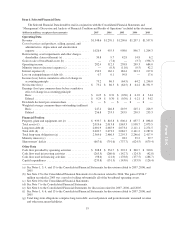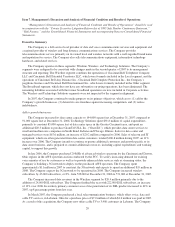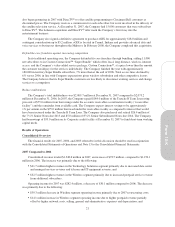Cincinnati Bell 2007 Annual Report Download - page 91
Download and view the complete annual report
Please find page 91 of the 2007 Cincinnati Bell annual report below. You can navigate through the pages in the report by either clicking on the pages listed below, or by using the keyword search tool below to find specific information within the annual report.
Wireless competes against national, well-funded wireless service providers in the Cincinnati and Dayton,
Ohio metropolitan market areas, including AT&T, Sprint Nextel, T-Mobile, Verizon and Leap. In addition, Time
Warner Cable entered into a joint venture with Sprint Nextel. This joint venture purchased spectrum licenses in
2006 during the AWS spectrum auction conducted by the FCC and in 2007 began to offer wireless services. The
Company anticipates that continued competition could compress its margins for wireless products and services as
carriers continue to offer more minutes for equivalent or lower service fees while CBW cannot offer more
minutes without incremental capital expenditures and operating costs. CBW’s ability to compete will depend, in
part, on its ability to anticipate and respond to various competitive factors affecting the telecommunications
industry.
Furthermore, there has been a trend in the wireless communications industry towards consolidation through
joint ventures, reorganizations, and acquisitions. The Company expects this consolidation trend to lead to larger
competitors with greater resources and more service offerings than CBW. In addition, wireless subscribers are
permitted to retain their wireless phone numbers when changing to another wireless carrier within the same
geographic area. The Company generally does not enter into long-term contracts with its wireless subscribers,
and therefore, this portability could have a significant adverse affect on the Company. The Company also
believes that these wireless competitors and in particular, companies that offer unlimited wireless service plans
for a flat monthly fee, are a cause of CBT’s access line loss.
Technology Solutions competes against numerous other information technology consulting, web-hosting,
data center and computer system integration companies, many of which are larger, national in scope, and better
financed. This market is rapidly evolving, highly competitive and likely to be characterized by over-capacity and
industry consolidation. Other competitors may consolidate with one another or acquire software application
vendors or technology providers, enabling them to more effectively compete with Technology Solutions. The
Company believes that many of the participants in this market must grow rapidly and achieve a significant
presence to compete effectively. This consolidation could affect prices and other competitive factors in ways that
could impede Technology Solutions’ ability to compete successfully in the market.
The effect of the foregoing competition on any of the Company’s segments could have a material adverse
impact on its businesses, financial condition, results of operations, and cash flows. This could result in increased
reliance on borrowed funds and could impact the Company’s ability to maintain its wireline and wireless
networks.
Maintaining the Company’s networks requires significant capital expenditures and its inability or failure to
maintain its networks would have a material impact on its market share and ability to generate revenue.
During the year ended December 31, 2007, capital expenditures totaled $233.8 million, which included
$97.4 million of capital expenditures related to data center construction and building its 3G wireless network.
The Company expects to spend approximately 16% of 2008 revenue on capital expenditures, which includes
approximately $19 million to finish building its 3G wireless network. The Company also purchased 10MHz of
spectrum in the Indianapolis area in 2006. The Company is considering its options with respect to the
Indianapolis spectrum, which include expansion of its wireless operations into this area, which would require
significant capital expenditures, or lease of the spectrum to another wireless provider.
The Company currently operates nine data centers, including those acquired through the purchase of GramTel
in December 2007, and any further data center expansion will involve significant capital expenditures for data
center construction. In order to provide guaranteed levels of service to our data center customers, the network
infrastructure must be protected against damage from human error, natural disasters, unexpected equipment failure,
power loss or telecommunications failures, terrorism, sabotage, or other intentional acts of vandalism. The
Company’s disaster recovery plan may not address all of the problems that may be encountered in the event of a
disaster or other unanticipated problem, which may result in disruption of service to data center customers.
The Company may also incur significant additional capital expenditures as a result of unanticipated
developments, regulatory changes, and other events that impact the business. If the Company is unable or fails to
adequately maintain or expand its networks to meet customer needs, there could be a material adverse impact on
the Company’s market share and its ability to generate revenue.
11
Form 10-K


